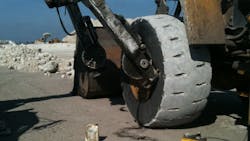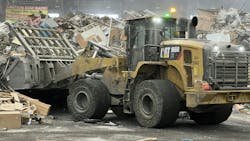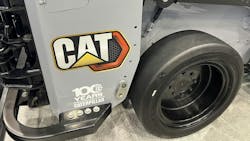When to Consider Solid, Flat-proof Tires
Key Highlights
In this article, you will learn:
- What applications work with solid tires.
- The key features are for solid tires.
- The key benefits of solid tires.
Tires are expensive; the wear and tear add up.
When a tire is punctured on off-road equipment, it’s not just a call to AAA. They can be large, awkward to move, and difficult to replace remotely—and while that replacement work is being done the equipment is not working.
Depending on the equipment and the applications, solid, airless tires might be an option.
More on tire maintenance
- Four tips for off-road tire maintenance.
- Match load to tire inflation pressure.
- Keep tire techs safe.
- Technology aids tire maintenance.
Though more expensive than air-filled (pneumatic) tires, the cost savings in avoiding frequent replacement may make the initial cost worth it. There are numerous benefits; the lack of flats is only one.
Solid tires are made of high-quality compounds. Tag Equipment, a tire, track, parts, and attachment seller in Ontario, Canada, says they are designed to have a lifespan three times longer than pneumatic tires.
They are also puncture resistant and have extra deep treads to provide more traction. Being bonded to their rims helps prevent tire slippage.
The benefits add up to produce better control in rough conditions and increased stability.
For skid steers specifically, which find themselves in all kinds of applications including difficult clean-up jobs in and around debris, solid tires allow them to work on and off-road, reduce shock-related damage to components, and add weight to further stabilize the machine.
Managers must decide which kind solid tire to purchase, all-terrain (with treads) or smooth (no treads).
All-terrain, treaded solid tires are designed for variable ground conditions, including dirt and mud. If used exclusively for on-road applications, they may not last the lifespan needed.
Smooth solid tires will not experience the kind of tread flexing that can lead to early wear. There is less traction, however, so they belong on flatter job sites where traction is not crucial.
For skid steers (and much of the information is also applicable to wheel loaders, another frequent user of solid tires) Tag has a handy solid versus pneumatic tire choice guide based on application.
- Construction. The right tire for a construction project will depend on ground conditions. Use pneumatic tires on job sites with smooth pavement. Flat-proof or solid tires can be ideal for rough terrain.
- Demolition. These jobs require durable, solid tires to move over debris and material on the ground.
- Recycling. Use solid tires to combat broken metal, glass, and other objects.
- Mining. What's on the haul road or underneath the cycle path of the loader? Pneumatic tires may be used with caution, but solid ones provide better performance on rough terrain.
- Standard usage. Use pneumatic tires for driving over dirt or sand.
Solid tires derive their benefits from special rubber compounds engineered to provide wear resistance and flexibility. These compounds can be mixed with additives to make them tougher.
Many solid tires also have reinforcing materials such as Kevlar fibers. Steel belts also may be used. Heat resistance is also “baked in,” allowing them to perform on extremely high temperature jobs.
Drilling down even further, there are several types of solid tires. Polyurethane filled tires are designed to provide the benefits of both pneumatic tires and solid tires by filling pneumatic tires with polyurethane. They become puncture proof and still have a cushioned ride.
Solid cushion tires are made for smooth operation on hard surfaces. They are suitable for indoor and urban environments.
Standard solid tires are comprised of solid rubber, for maximum puncture resistance and durability. Use them for heavy-duty jobs or on rough terrain.
Mounting flat-proof tires
Understanding how they are secured to the rim is crucial for any compact equipment owner or operator.
There are three types of solid tire mounts: press-on, rim-bonded, and segmented. The choice between them is a vital factor their longevity and overall performance.
Press-on tires are known for their robustness and resilience in demanding work environments. As the name indicates, they are pressed onto the rim by stretching the rubber over it. Friction helps hold the rubber to the rim. There is no air necessary.
They are usually the least costly of the options.
Rim-bonded tires are chemically bonded to the rim, ensuring a secure and stable connection. The method is ment to reduce the chances of slippage or separation during heavy-duty operations.
These tires can be expensive upon replacement because they need to replaced in their entirety, and the chemicals involved in the bonding may require managers to seek professional assistance.
Segmented tires feature a multipiece design and are mostly for versatility. The segmented design improves shock absorption and allows replacement of individual segments for ongoing maintenance. No special equipment is needed to retread.
The areas between segments will need periodic cleaning to keep any debris from collecting.
Remember the basics
Yokohama Tire and its Galaxy brand stresses that managers, no matter what their choice, should adhere to the basics: inspection, rotation, and operator education.
Just because solid tires need less maintenance doesn’t equate to no maintenance. Be sure to inspect tires regularly to clear debris from the tread and wipe off any oil, grease, or chemicals that have come in contact with the tire.
It is also essential to routinely check tires for wear. Yokohama recommends to prioritize the replacement of tires worn to the 60-J line, also known as the safety line, a marker found on the sidewall of solid tires that indicates when they’re ready for replacement.
Operating solids below the 60-J line is a safety hazard and can lead to downtime. It’s recommended to replace press-on solids—like the Galaxy YM SDS Press-On—when the overall rubber depth reaches 2/3 of the original rubber depth. Another issue to keep an eye out for is uneven wear.
Unevenly worn solid tires can make equipment unstable and increase the risk of an accident. It’s common for either front tires or rear tires to wear faster than their counterparts—depending on application—and incorporating tire rotation into the maintenance schedule of a wheel loader or skid steer is a proven strategy for ensuring all four tires wear evenly.
The frequency of rotation will vary due to factors like application and duty cycles—however, a good rule of thumb is to rotate tires at the first sign of uneven wear.
Operators play a major role in the life of solid tires, Yokohama says, because "burning rubber is also burning tire life." Everything from skidding to sharp turns to abrupt braking takes a toll on tires and speeds up wear.
Investing time in training, encouraging conservative driving practices, and recruiting and retaining skilled operators can all pay off in longer tire life.
About the Author
Frank Raczon
Raczon’s writing career spans nearly 25 years, including magazine publishing and public relations work with some of the industry’s major equipment manufacturers. He has won numerous awards in his career, including nods from the Construction Writers Association, the Association of Equipment Manufacturers, and BtoB magazine. He is responsible for the magazine's Buying Files.



